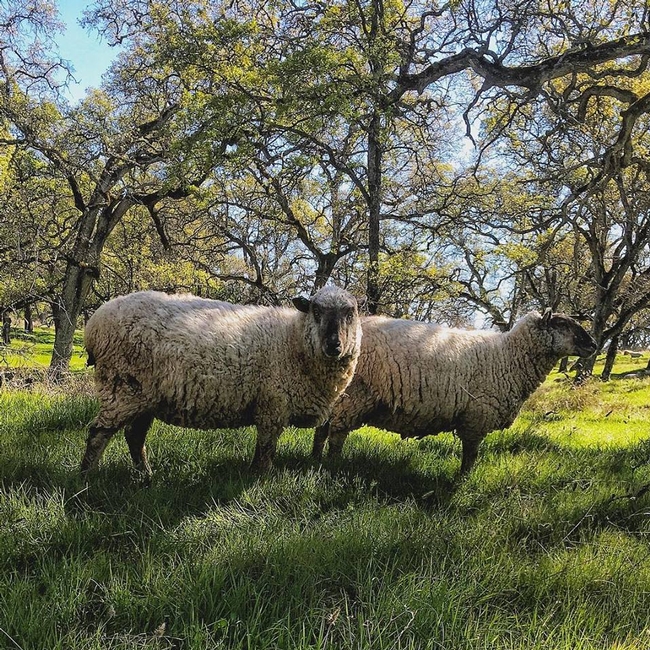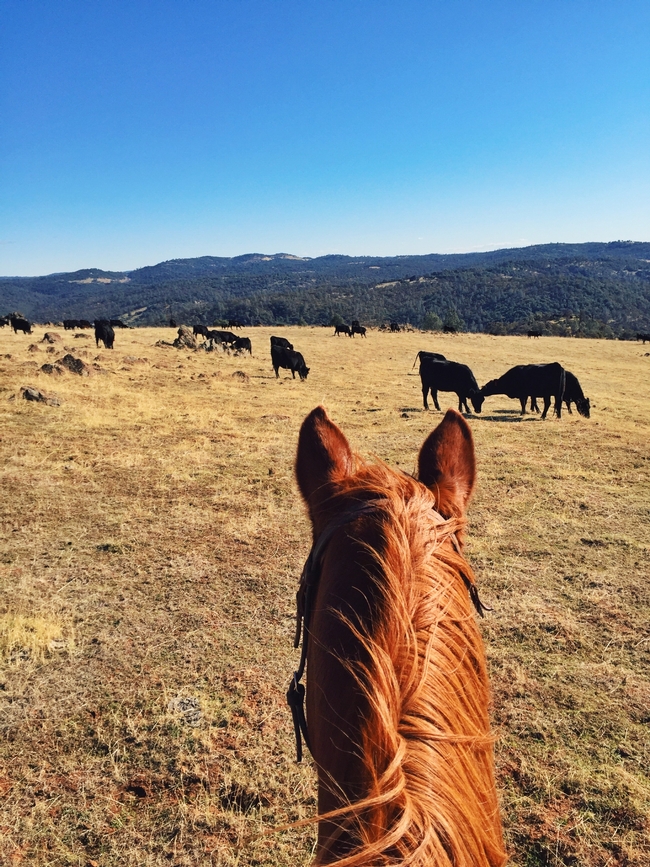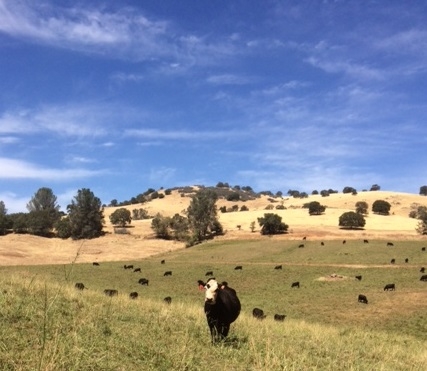- Author: Dan Macon
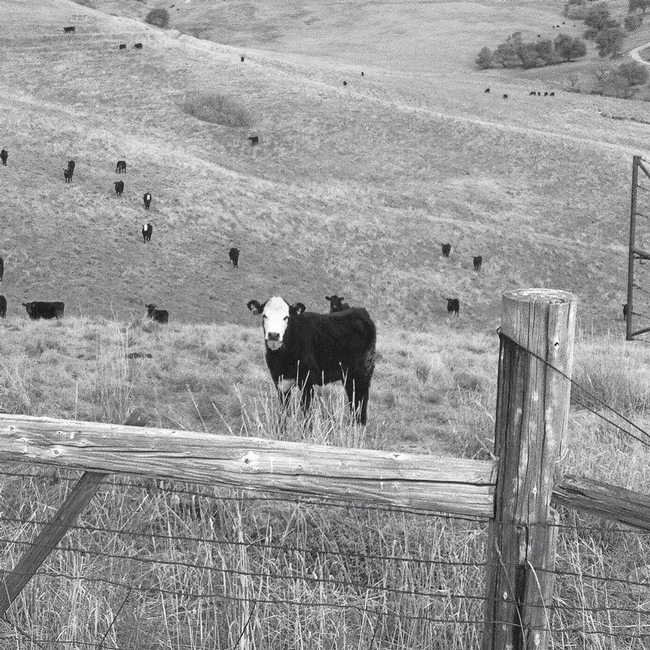
Researchers at the UC Sierra Foothill Research and Extension Center (SFREC) in Browns Valley have been collecting rangeland forage production data since 1979. As a rangeland geek, grazier, and now livestock farm advisor, I find it fascinating to look back at the tremendous variability in forage growth over the last 39 years - partly, I suppose, to help predict the short-term future (in other words, this year's spring growth). From a practical standpoint, I find this dataset helpful for grazing planning purposes, as well.
Since the beginning, SFREC staff has noted germination dates for each year. Since the mid 1990s, the staff has also measured total available rangeland forage on the first day of the month from December through peak standing crop (which generally occurs sometime in May or early June). The average germination date over that time is October 21 - although germination has occurred as early as September 2 (in 2000) and as late as December 12 (in 2002). Interestingly, total production was right at average in 2000-2001, while the much later germination year (2002-2003) produced 145% of normal forage. Timing of precipitation after germination seems to be a critical factor!
As I said at the outset, annual rangeland forage production is incredibly variable. Total production over the last 39 years has ranged from 1,071 pounds of dry matter per acre in 1987-88 to 4,696 pounds per acre in 1992-93. Monthly production is also all over the board - on February 1, 2014, the crew measured just 98 pounds of dry matter per acre (average for the date is 533 pounds). I remember that February well - my family and I sold about a third of our commercial ewes because we simply didn't have enough grass.
Forage production on annual rangeland, obviously, is tied to precipitation. The relationship, however, is complex. Total precipitation is probably not as important as the timing. Air and soil temperatures are also related to grass growth, as this year's numbers clearly demonstrate. Here in Auburn (and I suspect in Browns Valley), our seasonal rainfall has been up and down. We had good rains in November, a relatively dry and warm December, a wet and warm January, and through this week, a dry February. As of today, our precipitation is about 80 percent of normal for our part of the foothills. This year's February 1 forage production at SFREC was a whopping 957 pounds of dry matter per acre - nearly 180 percent of normal for the date. And to think that back in late December I was worried about having enough grass this spring!
The timing of moisture also impacts the date at which we reach peak standing crop. With the dry weather and north wind we've had up until this week, I wondered if our annual grasses would mature earlier than normal. Antecdotally, some of the lower elevation ranchers I've spoken with in the last several weeks reported that the grasses on their shallower soils were starting to show signs of heading out. And talking to friends who ranch in other parts of the state (especially the Central and South Coasts and the San Joaquin Valley), the grass in our Sierra foothills is the exception rather than the rule this year. Some parts of the state do not have any green forage at all.
So what can we do with these numbers from a practical standpoint? I use the monthly numbers for planning purposes - a dry, cold autumn followed by a dry December and January means we'll be tight on forage in February (like 2013-14). Conversely, adequate moisture and warmer-than-usual temperatures (like last year and, at least in our region, this year) means extra forage in February. I also use the peak standing crop information to plan for summer and fall grazing. If we know how much we've grown, we can ration out our dry forage and make sure we leave enough residual to protect the soil when the rains start again in the fall.
Experienced ranchers, obviously, know the difference between a good grass year and a poor one. The data collected at SFREC helps put numbers to this variation - numbers that can help all of us become better managers!
- Author: Dan Macon
Several new online resources from the University of California can help ranchers learn about a wide array of resource and ranch management issues!
There's an app for that!
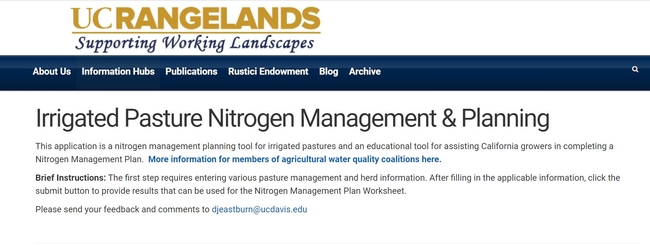
Livestock Protection Tools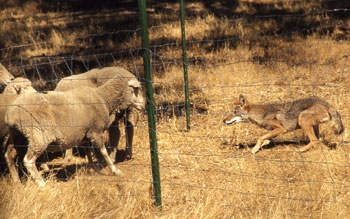
A new publication from UCANR helps ranchers evaluate a variety of tools for protecting livestock from predators. Livestock Protection Tools for California Ranchers provides a summary of current research, as well as on-the-ground experience from ranchers throughout the West regarding livestock guardian animals, electric fencing, and other nonlethal tools.
UC Rangelands Information Hubs
The UC Rangelands website has a variety of outstanding information hubs for ranchers and land managers. These webpages include California-focused research and information on:
- Livestock-Predator Interactions
- Rangeland Water Quality
- Irrigated Pasture
- Rangeland Drought
- Public Lands
- Rangeland Decision-Making
- Author: Dan Macon
Note: this is the third and final installment in a series of posts on nonlethal livestock protection tools. Click here to see the first in the series. All three posts are adapted from:
Macon, D.K, R.A. Baldwin, D.F. Lile, J. Stackhouse, C.K. Rivers, T. Saitone, T.K. Schohr, L.K. Snell, J. Harper, R. Ingram, K. Rodrigues, L. Macaulay, and L.M. Roche. IN PRESS. Livestock protection tools for California ranchers. Oakland: University of California Division of Agriculture and Natural Resources Publication 8598 (in press).
Sometimes, simply being in the right place at the right time can prevent depredation on livestock. Human presence, which can include hazing and other fright tactics, can modify carnivore hunting patterns and dietary preferences (Bangs et al. 2006).
Many large-scale sheep operations in California use herders to manage their day-to-day operations - these herders can be a predator deterrent. Individual ranchers, rancher associations, or nonprofit organizations may employ range riders. Range riders have mostly been used in areas with potential wolf-livestock conflicts, often with the specific task of disrupting predatory behavior. It has also been suggested that low-stress stockmanship techniques can re-instill herd instinct in cattle.
While there is little empirical evidence regarding effectiveness of range riders, herders, or stockmanship techniques, ranchers perceive the benefits of range rider programs to include depredation mitigation, increased management and information on livestock, rapid carcass identification, and a variety of social benefits (including reduced stress, reduced trespass and littering, improved public perception, and trust building). Range riders can also provide additional tools beyond simply being present on the landscape, including carcass removal, treatment of injured or sick animals, and stockmanship (Parks 2015).
On the other hand, wolves, especially, may become habituated to seeing humans, avoiding areas where they see humans during daylight hours and returning at night (Parks 2015; Williams personal communication 2016). Varying the pattern of human presence appears to be critical to preventing habituation. Finally, range rider programs may be cost-prohibitive in the long term. Most existing range rider programs are funded through combination of grant funding (from nonprofit organizations and/or government agencies) and in-kind contributions from ranchers (e.g., housing, horses or ATVs, investment of time, etc.). Ranchers who have participated in range rider programs in the northern Rocky Mountains perceive the costs to outweigh the benefits (Parks and Messmer 2016).
If you're interested in learning more about the nuts-and-bolts of range riding as a predator protection technique, Defenders of Wildlife is offering a 2-day range rider school near Chester, CA on February 20-21. Contact me at dmacon@ucanr.edu if you'd like more information.
Obviously, the tools I've described in this series of blog posts fit some situations better than others. Predator behavior, like livestock and human behavior, is dynamic. Predators can become habituated to some tools; as producers, we have to adapt our strategies to these changing conditions. For example, we've used llamas to protect small groups of sheep at our home place. Eventually, the coyotes learned that our particular llama wasn't a threat - and we lost a ram. Our adaptation at home was to night pen the sheep. On the other hand, our particular combination of livestock guardian dogs and electric fence on our leased pastures has been highly effective.
For more information, be sure to check out the Livestock-Predator Info Hub at http://rangelands.ucdavis.edu/predator-hub/. And please share your experiences in protecting your livestock!
- Author: Dan Macon
Last week, we kicked off our 11th annual Farm and Ranch Business Planning Short Course. Every Thursday night for the next six weeks, a group of local farmers and ranchers will come together to discuss and learn about operating an economically viable agricultural business. The class is intense - but very rewarding!
Several weeks into the course, we'll talk about purchasing equipment. For the farmers in the class, this discussion usually centers on tractors. This seems to be a “guy” thing – the male of our species can't conceive of a commercial farming enterprise without a tractor! For most small-scale foothill crop farms, however, a tractor shouldn't be the first capital expenditure. Things like deer fencing, irrigation systems and hand tools are far more critical to a small-scale vegetable grower – buying a tractor to cultivate an acre of crops just doesn't make economic sense.
Start-up livestock operations face similar decisions relative to capital expenditures. In many ways, squeeze chutes and corral panels (or tilt tables and sheep yards for new sheep producers) are similar to that shiny new tractor – there must be something enticing about shiny paint on steel equipment! Despite my own attraction to shiny things, our commercial sheep operation has always been under-capitalized. I've never had enough money all at once to go out and buy the breeding animals, fencing, equipment and tools I needed in one fell swoop. Consequently, I've been forced to prioritize my capital purchases. For livestock, at least, I think new (and established) producers should ask themselves three key questions regarding capital purchases:
- Will this purchase increase my production?
- Will this purchase reduce my overhead?
- Is there a less expensive alternative to accomplishing the same goal?
There are a variety of economic analysis tools we use in our Business Planning Short Course to help farm and ranch businesses answer these questions. One of the simplest tools is to calculate a simple payback period. If we know how much money the capital purchase will generate (or how much we'll save in time or other inputs), we can simply estimate the length of time it will take pay off the purchase.
While calculating a payback period is simple, it ignores additional returns (or savings) after the end of the payback period, as well as the impact of the investment on the timing of cash flows. Other analyses may be helpful in providing a more detailed evaluation of a capital purchase. These include:
- Simple Rate of Return: Calculated as the average annual net return divided by the initial cost. A purchase with a higher simple rate of return might make more sense than one with a lower rate.
- Net Present Value: Most of us intuitively know that we'd rather get a dollar today than wait for that same dollar next year. This is due largely to risk - inflation risk, risk that the dollar won't be available next year. Net present value analysis allows us to compare the potential income (or savings) from alternative capital purchases in today's dollars. This type of analysis takes into account the fact that different capital purchases may have different useful lives, costs of ownership (like maintenance) and salvage values. It also accounts for the timing of these savings or benefits - a purchase that generates more revenue or savings early in its useful life will have a greater net present value.
While I've been known to make impulsive purchases on occasion, these types of analyses have become an important part of my business planning tool box. For example, our homemade sheep corrals (which cost us less than $500 in materials) function just as well (and are nearly as portable) as a set of $15,000 Prattley sheep yards. In this case, we were able to find a less costly option that fulfilled our needs. Our payback period was less than a year. On the other hand, we may be better off purchasing a new ATV when our current bike finally wears out - we'll do a net present value analysis to compare our alternatives.
While this year's Farm and Ranch Business Planning Short Course is full, consider signing up next year! Based on feedback from previous students, it might be the best investment you can make in your business!
- Author: Dan Macon
Most ranchers track production – pounds of calves or lambs sold, seasonal gain on stocker cattle or feeder lambs, or pounds of wool shorn are all measures of ranch productivity. These are the benchmarks that we compare year-to-year – or across the fence with our neighbors! However, ranches produce more than just livestock – they provide wildlife and native plant habitats, water filtration, fuel reduction, and cultural landscapes. These “ecosystem services” are increasingly valued as important reasons to conserve working ranches.
What are Rangeland Ecosystem Services?
California rangelands are biologically and climatically diverse, and ranchers utilize a variety of public and private lands. Within Placer, Nevada, Sutter and Yuba Counties, working ranches often represent the “wide open spaces” and iconic oak woodlands of our foothill communities. They also provide migration corridors and other habitat values for wildlife. Well-managed grazing land in our 4-county region supports a wide variety of wildlife, including red-legged frogs, burrowing owls, and Swainson's hawks, to name a few. These lands also provide important habitat types, like vernal pools and blue oak woodlands. Yet despite these critical ecosystem services, rangelands have become highly fragmented - and increasing land values make it difficult for the next generation of ranchers to get started.
Payments for Ecosystem Services
Rangeland ecosystem services provide value beyond the market price of your livestock. How can you take advantage of these values?
- Conservation easements allow landowners to realize some of the capital value of their land without selling; rather, the landowner voluntarily exchanges future development rights for payment or tax reductions. As one example, the California Rangeland Trust focuses on funding conservation easements for ranchlands.
- Cost-share programs like the federal Environmental Quality Incentives Program and Conservation Stewardship Program fund on-ranch conservation practices. A local example is the Placer County Water Agency and Placer County Resource Conservation District, which offer cost-share funds for irrigation water conservation efforts.
- Certification and eco-labeling programs help consumers support ranchers directly – rewarding ecologically beneficial management. Despite the potential, many labeling and certification efforts are still under development.
Future Opportunities in our 4-County Region
Suburban growth and a rapidly changing environment in our region makes rangeland ecosystem services even more 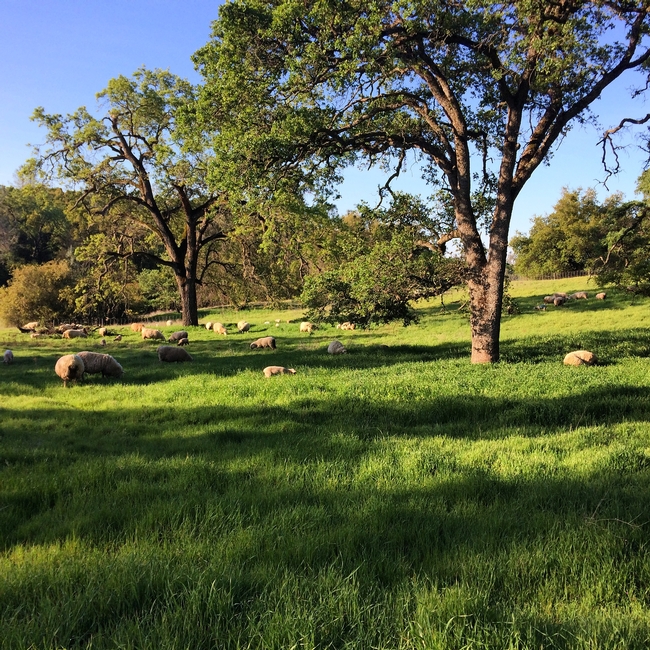
For more reading: http://www.sciencedirect.com/science/article/pii/S0190052814500727


